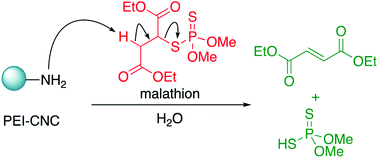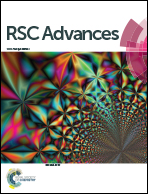Degradation of pesticides using amine-functionalized cellulose nanocrystals†
Abstract
A series of amine-functionalized cellulose nanocrystal materials were successfully synthesized, characterized, and evaluated for the remediation of pesticide contaminants from organic and aqueous media. Their ability to degrade malathion in organic systems has been examined, resulting in up to 100% degradation of the compound into detectable lower molecular weight by-products. A poly(ethylenimine) cellulose nanocrystal (CNC-PEI) material was also capable of degrading aqueous solutions of malathion, deltamethrin, and permethrin with 100%, 95%, and 78% degradation, respectively. Thus, these materials can potentially serve as a new and viable remediation technique based on their ability to effectively degrade various pesticides. The reusability of the CNC-PEI was also explored. The CNC-PEI material maintained its ability to degrade malathion throughout two wash and re-use cycles.



 Please wait while we load your content...
Please wait while we load your content...